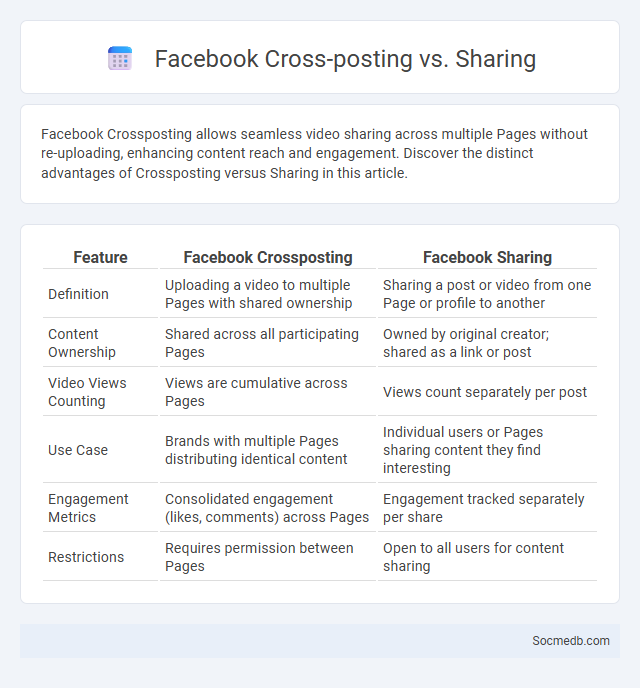
Photo illustration: Facebook Crossposting vs Sharing
Facebook Crossposting allows seamless video sharing across multiple Pages without re-uploading, enhancing content reach and engagement. Discover the distinct advantages of Crossposting versus Sharing in this article.
Table of Comparison
| Feature | Facebook Crossposting | Facebook Sharing |
|---|---|---|
| Definition | Uploading a video to multiple Pages with shared ownership | Sharing a post or video from one Page or profile to another |
| Content Ownership | Shared across all participating Pages | Owned by original creator; shared as a link or post |
| Video Views Counting | Views are cumulative across Pages | Views count separately per post |
| Use Case | Brands with multiple Pages distributing identical content | Individual users or Pages sharing content they find interesting |
| Engagement Metrics | Consolidated engagement (likes, comments) across Pages | Engagement tracked separately per share |
| Restrictions | Requires permission between Pages | Open to all users for content sharing |
Understanding Facebook Crossposting
Facebook crossposting allows content creators to share videos across multiple Facebook Pages without uploading duplicate videos, enhancing reach and engagement efficiently. This feature maintains video insights and allows seamless video management by consolidating analytics across all Pages involved. Utilizing Facebook crossposting optimizes content distribution strategies for brands managing multiple Page identities.
What Does Sharing Mean on Facebook?
Sharing on Facebook means you distribute content from others or your own posts to your timeline, groups, or pages, allowing your friends and followers to see and engage with the information. Your shared content can include photos, videos, links, or status updates that reflect your interests or opinions. This action amplifies reach and fosters interaction, shaping your digital presence and online relationships.
Key Differences: Crossposting vs Sharing
Crossposting involves publishing the same content simultaneously across multiple social media platforms, maximizing reach while maintaining consistent messaging. Sharing refers to redistributing existing posts within a single platform or between users, enhancing engagement through personalized interaction. Crossposting prioritizes broad exposure, whereas sharing emphasizes user-driven content amplification.
How Crossposting Works on Facebook
Crossposting on Facebook allows pages to share the same video content across multiple authorized pages without uploading duplicates, enhancing reach and engagement. When a video is crossposted, metrics like views, likes, and comments are consolidated, providing comprehensive insights. This feature streamlines content distribution, maximizes audience exposure, and maintains consistent branding across different pages.
Benefits of Crossposting Content
Crossposting content on social media maximizes reach by distributing the same message across multiple platforms, increasing audience engagement without additional content creation costs. This strategy enhances brand consistency and reinforces messaging, helping to build a cohesive online presence. Crossposting also saves time by streamlining the publishing process, allowing marketers to focus on analyzing performance and optimizing future campaigns.
Limitations of Facebook Sharing
Facebook sharing faces significant limitations in reach due to algorithmic filtering, which prioritizes content from close connections and popular pages, reducing organic visibility for most posts. Privacy settings and user control over shared content can restrict the audience, leading to fragmented dissemination and limited engagement. The platform's content moderation policies may also result in removal or suppression of shared posts that violate guidelines, further constraining sharing potential.
Effective Use Cases for Crossposting
Crossposting on social media maximizes content reach by sharing the same post across multiple platforms like Facebook, Instagram, and Twitter, saving time while ensuring consistent messaging. Brands leveraging crossposting see increased engagement rates, with studies showing up to a 20% boost in audience interaction due to broader exposure. Effective strategies involve tailoring captions and hashtags for each platform's audience while maintaining core content to drive cohesive brand awareness and optimize resource allocation.
Brands: When to Crosspost vs When to Share
Brands should crosspost on multiple social media platforms when targeting consistent messaging and maximizing reach without tailoring content to specific audiences. Sharing posts is more effective when aiming to maintain platform-specific engagement, as native sharing supports algorithm preferences and authentic interactions. Understanding each platform's user behavior and content format is crucial for optimizing brand visibility and engagement.
Best Practices for Facebook Content Distribution
Maximize your Facebook content reach by posting consistently during peak engagement hours identified through Facebook Insights. Utilize a mix of content types such as videos, images, and polls to increase interaction and algorithm favorability. Encourage your audience to engage by asking questions or prompting shares, enhancing your content's visibility in their news feeds.
Crossposting and Sharing: Impact on Engagement
Crossposting and sharing across multiple social media platforms significantly increase content visibility, leading to higher audience engagement rates. By tailoring posts to each platform's unique features and audience preferences, brands can maximize interaction such as likes, comments, and shares. This strategic distribution fosters broader reach and stronger community building, enhancing overall social media performance.
 socmedb.com
socmedb.com